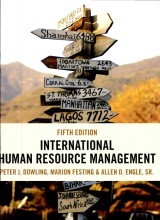Summary: International Human Resource Management Managing People In A Multinational Context | 9781844805426 | Peter J Dowling, et al
- This + 400k other summaries
- A unique study and practice tool
- Never study anything twice again
- Get the grades you hope for
- 100% sure, 100% understanding
Read the summary and the most important questions on International Human Resource Management Managing People in a Multinational Context | 9781844805426 | Peter J. Dowling; Marion Festing; Allen D. Engle
-
1 introduction
-
what are the three broad approaches of international HRM?
cross-cultural management : examine human behaviour within organizations from an international perspecitive
comparative HR and IR systems: compares industrial relations and HRM literature
IHRM in the multinational context: focus on aspacts of HRM in multinationals -
what is HRM and what activities does it include?
the activities undertaken by an organization to effectively utilize its human resources- human resource planning
- staffing
- performance management
- training and development
- compensation and benefits
- industrial relations
-
what are Morgan's three dimension for explaining IHRM
- the HR activities of procurement, allocation and utilization (or the six)
- country of operation
- host-country where a subsidiary is located
- the parent country where the headquater is located
-"other" countries that may be the source of labor, finance and other imputs
3. type employee
-host-country nationals (HCN)
-parent-country nationals (PCN)
-third-country nationals (TCN) -
what differentiates domestic HRM from IHRM according to Dowling?
- more HRM activities
- the need for broader perspective
- more involvement in employee's personal lives
- changes in emphasis as the workforce is a mix of expatriates and locals
- risk exposure
- broader external influences
-
name examples of more international HR activities
- international taxation
- international relocation and orientation
- administrative services for expatriates
- host-government relations
- language translation services
-
what includes international relocation and orientation?
- arranging pre-departure training
- providing immigration and travel details
- providing housing, medical care, recreation and schooling
- finalizing compensation details
-
what are four other factors that moderate differences between domestic and IHRM next to complexity?
- cultural environment
- industry
- reliance on its home-country domestic market?
- attitudes of senior management
-
2 the cultural context of IHRM
This is a preview. There are 2 more flashcards available for chapter 2
Show more cards here -
name examples how cultural contexts effect HRM practises
recruitment and sellection- societies low on collectivism, individual achievements are important
- societies high in collectivism, team-related skills are important
training and development- societies high on gender egalitarianism, women have the same chances for career as men
- societies low on gender egalitarianism, female managers are are
compensation- societies high on uncertainty avoidance, employees don't like to take risks and prefer fixed compensation packages
- societies low on uncertainty avoidance, employees are risk-taking and accapt performance based pay
task distribution- societies high on collectivism prefer group work
- societies high on individualism rather have own respnsibilities
-
cultural dimension by Hall
high vs low context
spatial orientaion - distance
monochrome vs polychrome
information speed -
4 IHRM in cross border mergers, acquisitions, international alliances and SME
This is a preview. There are 9 more flashcards available for chapter 4
Show more cards here -
what are equity and non-equity modes?
equity- subsidiaries
- joint ventures
- mergers and aquisitions
non-equity modes- franchising
- licensing
- management contracts
- Higher grades + faster learning
- Never study anything twice
- 100% sure, 100% understanding
































